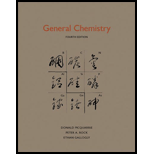
Concept explainers
Interpretation:
The final temperature of
Concept Introduction:
Molar enthalpy for a process is heat energy needed by one mole of a substance to undergo change in the process. The heat energy that change the temperature of
Here,
The heat energy absorbed by n mole of substance to undergo change is as follows:
Here,
Answer to Problem 15.77P
The final temperature for mixture of ice and water is
Explanation of Solution
Consider the final temperature to be
Ice undergoes 3 processes when put in a water container. In the first process it cools from
The density of
The formula to determine moles of ice is as follows:
Substitute
The temperature difference (
The size difference on kelvin and Celsius scale is equal so
The formula to calculate heat energy required to cool
Substitute
The expression to estimate the heat absorbed to by ice to melt is as follows:
Substitute
The temperature difference (
The size difference on kelvin and Celsius scale is equal so
The expression tocalculate heat energy required to cool
Substitute
The formula to determine moles of water is as follows:
Substitute
The temperature difference (
The size difference on kelvin and Celsius scale is equal so
The formula to calculate heat energy required to cool
Substitute
As there is no loss of heat to or from the surrounding hence there will be conservation of energy that is heat gained by
Substitute
Rearrange above equation to calculate
Rearrange above equation further to calculate
The final temperature for mixture of ice and water is
Want to see more full solutions like this?
Chapter 15 Solutions
General Chemistry
 ChemistryChemistryISBN:9781305957404Author:Steven S. Zumdahl, Susan A. Zumdahl, Donald J. DeCostePublisher:Cengage Learning
ChemistryChemistryISBN:9781305957404Author:Steven S. Zumdahl, Susan A. Zumdahl, Donald J. DeCostePublisher:Cengage Learning ChemistryChemistryISBN:9781259911156Author:Raymond Chang Dr., Jason Overby ProfessorPublisher:McGraw-Hill Education
ChemistryChemistryISBN:9781259911156Author:Raymond Chang Dr., Jason Overby ProfessorPublisher:McGraw-Hill Education Principles of Instrumental AnalysisChemistryISBN:9781305577213Author:Douglas A. Skoog, F. James Holler, Stanley R. CrouchPublisher:Cengage Learning
Principles of Instrumental AnalysisChemistryISBN:9781305577213Author:Douglas A. Skoog, F. James Holler, Stanley R. CrouchPublisher:Cengage Learning Organic ChemistryChemistryISBN:9780078021558Author:Janice Gorzynski Smith Dr.Publisher:McGraw-Hill Education
Organic ChemistryChemistryISBN:9780078021558Author:Janice Gorzynski Smith Dr.Publisher:McGraw-Hill Education Chemistry: Principles and ReactionsChemistryISBN:9781305079373Author:William L. Masterton, Cecile N. HurleyPublisher:Cengage Learning
Chemistry: Principles and ReactionsChemistryISBN:9781305079373Author:William L. Masterton, Cecile N. HurleyPublisher:Cengage Learning Elementary Principles of Chemical Processes, Bind...ChemistryISBN:9781118431221Author:Richard M. Felder, Ronald W. Rousseau, Lisa G. BullardPublisher:WILEY
Elementary Principles of Chemical Processes, Bind...ChemistryISBN:9781118431221Author:Richard M. Felder, Ronald W. Rousseau, Lisa G. BullardPublisher:WILEY





